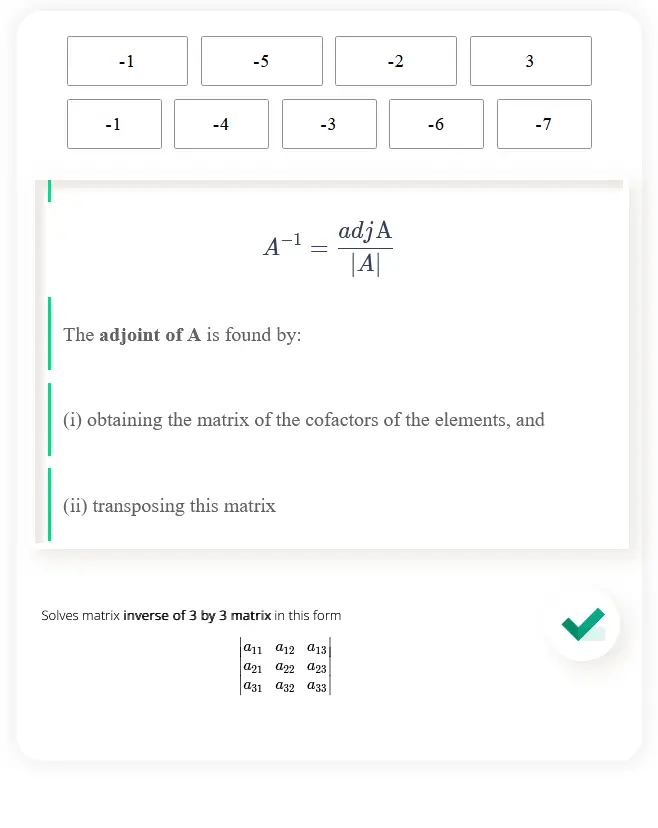Solves matrix inverse of 3 by 3 matrix in this form \[ \begin{vmatrix} a_{11} \ \ \ a_{12} \ \ \ a_{13} \\ a_{21} \ \ \ a_{22} \ \ \ a_{23} \\ a_{31} \ \ \ a_{32} \ \ \ a_{33} \end{vmatrix} \]

MathCrave Inverse of 3 x 3 Matrix step by step solver is a powerful matrix solver designed to solve complicated process of finding the inverse of a 3 x 3 matrix. The calculator offers a convenient and efficient solution for mastering the intricacies of matrix inversion.
The inverse 3x3 matrix is a matrix that, when multiplied by the original matrix, yields the identity matrix. In other words, if A is a 3x3 matrix and A^(-1) is its inverse, then A A^(-1) = A^(-1) A = I, where I is the identity matrix. The inverse of a 3x3 matrix exists only if the determinant of the matrix is not zero.
To find the inverse of a 3x3 matrix, we can apply the following formula:
A^(-1) = (1/det(A)) * adj(A)
Where:
A^(-1) is the inverse of matrix A.
det(A) denotes the determinant of matrix A.
adj(A) represents the adjugate of matrix A.
Note: The denominator in the formula ensures that the inverse is scaled correctly.
To solve the inverse or reciprocal of a 3 by 3 matrix, follow these steps:
1. Start with a 3 by 3 matrix A in the form:
[a, b, c]
[d, e, f]
[g, h, i]
2. Calculate the determinant of matrix A using the formula:
det(A) = a(ei - fh) - b(di - fg) + c(dh - eg)
3. Check if the determinant is equal to zero. If det(A) = 0, then the matrix is not invertible. In this case, the inverse does not exist.
4. If det(A) is not zero, proceed to find the inverse. The inverse of A is given by:
A^(-1) = (1/det(A)) * adj(A)
5. Calculate the determinant of each minor matrix formed by removing one row and one column of A as follows:
Minor matrix M_11: [e, f; h, i]
Minor matrix M_12: [d, f; g, i]
Minor matrix M_13: [d, e; g, h]
Minor matrix M_21: [b, c; h, i]
Minor matrix M_22: [a, c; g, i]
Minor matrix M_23: [a, b; g, h]
Minor matrix M_31: [b, c; e, f]
Minor matrix M_32: [a, c; d, f]
Minor matrix M_33: [a, b; d, e]
6. Calculate the co-factor matrix by assigning alternating positive and negative signs to the corresponding minor determinants:
Co-factor C_11 = M_11
Co-factor C_12 = - M_12
Co-factor C_13 = M_13
Co-factor C_21 = - M_21
Co-factor C_22 = M_22
Co-factor C_23 = - M_23
Co-factor C_31 = M_31
Co-factor C_32 = - M_32
Co-factor C_33 = M_33
7. Transpose the co-factor matrix to obtain the adjugate matrix:
adj(A) = [C_11, C_21, C_31; C_12, C_22, C_32; C_13, C_23, C_33]
8. Divide the adjugate matrix by the determinant of A to find the inverse:
A^(-1) = (1/det(A)) * adj(A)
9. Calculate the reciprocal of each element of the inverse matrix to obtain the reciprocal matrix:
[1/(A^(-1))]
10. Simplify any fractions in the reciprocal matrix to their simplest form, if necessary.
Let's find the inverse of a given matrix using the formula provided above.
1. Calculate the determinant of matrix A:
det(A) = (2 0 2) + (3 2 3) + (1 1 1) - (1 0 3) - (2 1 2) - (3 3 1)
= 0 + 18 + 1 - 0 - 4 - 9
= 6
2. Calculate the adjugate of matrix A:
The adjugate of A is obtained by taking the transpose of the matrix of cofactors of A.
adj(A) = [[C11, C21, C31], [C12, C22, C32], [C13, C23, C33]]
Where Cij is the cofactor of element Aij. Solving the cofactor one row at a time.
C11 = (-1)^(1+1) det([[0, 2], [1, 2]]) = (-1)(1 x 2 - 2 x1) = -2 + 2 = 0
C12 = (-1)^(1+2) det([[1, 2], [3, 2]]) = (-1)(1 x 2 - 2 x 3) = -2 + 6 = 4
C13 = (-1)^(1+3) det([[1, 0], [3, 1]]) = (-1)(1 x 1 - 0 x 3) = -1
C21 = (-1)^(2+1) det([[3, 2], [1, 2]]) = (-1)(3 x 2 - 2 x 1) = 6 - 2 = 4
C22 = (-1)^(2+2) det([[2, 2], [3, 2]]) = (-1)(2 x2 - 2 x 3) = -4 + 6 = 2
C23 = (-1)^(2+3) det([[2, 0], [3, 1]]) = (-1)(2 x1 - 0 x 3) = -2
C31 = (-1)^(3+1) det([[3, 2], [0, 2]]) = (-1)(3 x2 - 2x 0) = 6
C32 = (-1)^(3+2) det([[2, 2], [0, 2]]) = (-1)(2 x2 - 2 x 0) = 4
C33 = (-1)^(3+3) det([[2, 0], [0, 2]]) = (-1)(2 x2 - 0 x 0) = 4
Therefore, adj(A)
=[[C11, C21, C31], [C12, C22, C32], [C13, C23, C33]]
= [[0, 4, -1], [4, 2, -2], [6, 4, 4]]
3. Calculate the inverse of matrix A:
A^(-1) = (1/6) adj(A) = (1/6) * [[0, 4, -1], [4, 2, -2], [6, 4, 4]]
= [[0, 2/3, -1/6], [2/3, 1/3, -1/3], [1, 2/3, 2/3]]
Therefore, the inverse of matrix A is
A^(-1) = [[0, 2/3, -1/6], [2/3, 1/3, -1/3], [1, 2/3, 2/3]].
The Inverse Matrix Theorem states that a square matrix A is invertible if and only if its determinant det(A) is non-zero. If A is invertible, then the formula mentioned above holds true.
